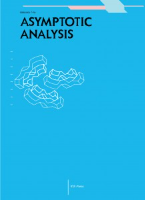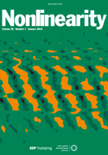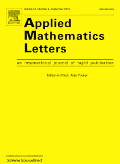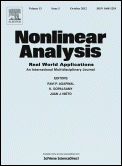
Differential Equations & Applications
Scope & Guideline
Exploring the Intersection of Theory and Application
Introduction
Aims and Scopes
- Nonlinear Differential Equations:
The journal publishes research on the existence, uniqueness, and stability of solutions to nonlinear differential equations, exploring various types of boundary conditions and their implications. - Fractional Differential Equations:
A significant focus is placed on fractional differential equations, which extend the concept of derivatives to non-integer orders, allowing for more complex modeling of real-world phenomena. - Systems and Control Theory:
Papers often delve into systems of differential equations, particularly in control theory, where the stability and behavior of dynamic systems are analyzed. - Applications to Physics and Engineering:
The journal showcases applications of differential equations in fields such as physics, biology, and engineering, demonstrating the practical significance of theoretical research. - Mathematical Methods and Techniques:
Research often involves the development of new mathematical methods for solving differential equations, including analytical and numerical techniques. - Asymptotic and Qualitative Analysis:
The journal emphasizes asymptotic behavior and qualitative properties of solutions, providing insights into long-term behavior and stability of differential systems.
Trending and Emerging
- Fractional Calculus:
There is a notable increase in research related to fractional calculus, focusing on the properties and applications of fractional differential equations, which are becoming increasingly relevant in modeling complex systems. - Impulsive Differential Equations:
Research on impulsive differential equations is gaining traction, as these equations incorporate sudden changes in systems, making them applicable in various scientific fields, including biology and control systems. - Nonlocal Boundary Value Problems:
Emerging studies are addressing nonlocal boundary value problems, which consider conditions that are not confined to the boundary of the domain, thus expanding the scope of differential equations applications. - Dynamic Systems and Stability Analysis:
There is an increasing focus on the stability analysis of dynamic systems, particularly in the context of non-autonomous systems, which are crucial for understanding real-world phenomena. - Numerical Methods for Differential Equations:
The development and application of advanced numerical methods for solving complex differential equations is trending, as computational approaches become more integral to research in this field.
Declining or Waning
- Basic Theoretical Frameworks:
Earlier years saw a significant amount of research dedicated to foundational theories in differential equations. However, recent publications suggest a shift towards more application-oriented and complex systems, indicating a waning interest in purely theoretical frameworks. - Elementary Differential Equations:
There appears to be a decline in papers focusing on elementary or classical differential equations, as researchers increasingly explore advanced topics such as fractional and impulsive differential equations. - Static Models:
Research centered around static models that do not incorporate time-dependent behavior has decreased, reflecting a growing preference for dynamic systems that better represent real-world applications. - Single-Variable Differential Equations:
The journal has seen a reduction in studies focusing on single-variable differential equations, moving towards more complex multi-variable and system-based approaches.
Similar Journals

ASYMPTOTIC ANALYSIS
Pioneering Research in Asymptotic Analysis and BeyondASYMPTOTIC ANALYSIS, published by IOS PRESS, is a leading international journal dedicated to the field of mathematics, specifically focusing on asymptotic methods and their applications across various mathematical disciplines. Established in 1988, this journal has established a strong reputation, achieving a Q1 category in 2023 within the miscellaneous mathematics category, indicating its significant impact and recognition in the academic community with a Scopus rank of 120 out of 399. With a commitment to advancing theoretical knowledge and fostering mathematical innovation, ASYMPTOTIC ANALYSIS serves as an essential resource for researchers, professionals, and students alike, facilitating the dissemination of groundbreaking findings and methodologies. Although the journal does not currently offer open access, it continuously strives to maintain high editorial standards and broaden the accessibility of its content. With its focus on critical aspects of mathematics, ASYMPTOTIC ANALYSIS will surely remain at the forefront of scholarly exchange, influencing future research directions and educational practices in the mathematical sciences.

NONLINEARITY
Advancing Insights in Nonlinear ScienceNONLINEARITY is a premier academic journal published by IOP Publishing Ltd, dedicated to advancing the field of complex systems through the lens of nonlinear science. Since its inception in 1988, the journal has established itself as a vital resource for researchers and professionals alike, offering a robust platform for disseminating high-quality research in areas such as applied mathematics, mathematical physics, and statistical and nonlinear physics. With an impressive Q1 ranking across multiple pertinent categories, including Applied Mathematics and Mathematical Physics, NONLINEARITY ranks among the top journals globally, making it essential reading for those seeking to deepen their understanding of nonlinear phenomena. Although it does not operate under an open-access model, its rich repository of rigorous articles significantly contributes to academia, fostering innovative thought and facilitating cutting-edge research. Located in the heart of the United Kingdom at TEMPLE CIRCUS, TEMPLE WAY, BRISTOL BS1 6BE, NONLINEARITY continues to be at the forefront of the scientific community, championing new discoveries and interdisciplinary dialogue within its dynamic scope.

Differential and Integral Equations
Advancing Knowledge in Differential and Integral EquationsDifferential and Integral Equations is a renowned peer-reviewed journal published by KHAYYAM PUBL CO INC, focusing on the rich and expanding field of mathematical analysis and applied mathematics. With its ISSN 0893-4983, this journal serves as a critical platform for disseminating innovative research, particularly in the areas of differential and integral equation theory and its applications across various scientific disciplines. Maintaining a significant presence in the academic community, it ranks in the Q2 category for both Analysis and Applied Mathematics as of 2023, highlighting its impact and relevance. The journal's indexed rankings place it at the 67th percentile in Mathematics - Analysis and the 54th percentile in Mathematics - Applied Mathematics, further establishing it as a valued resource for emerging researchers and established professionals alike. Although open access is not currently available, the journal remains crucial for those seeking to contribute to and stay informed on advancements in differential equations and their applications, with converged publication years from 1988 to 1995, 2009 to 2014, and continuing through 2016 to 2024. Researchers, professionals, and students will find that this journal provides essential insights and fosters collaboration within the dynamic mathematical community.

Journal of Dynamics and Differential Equations
Innovating Solutions Through Differential EquationsJournal of Dynamics and Differential Equations, published by SPRINGER, is a premier academic journal dedicated to advancing the understanding of dynamic systems and their mathematical foundations. Operating since its inception in 1989, the journal has become a vital resource for researchers and practitioners in the field, boasting a commendable Q1 ranking in the Analysis category as of 2023 and ranking #39 out of 193 journals in Mathematics Analysis on Scopus, placing it in the 80th percentile. While it maintains a traditional subscription model, its substantial contributions to the mathematics community—measured by a robust impact and adherence to high academic standards—make it essential reading for those engaged in differential equations and dynamical systems. The journal covers a broad scope of theoretical and applied research, positioning itself as a cornerstone for innovative studies and discussions, and ensuring its relevance to both contemporary and future mathematical inquiries.

Applied Mathematics Letters
Exploring Innovations at the Intersection of Math and Real-World ApplicationsApplied Mathematics Letters is a prestigious journal dedicated to the dissemination of significant research in the field of applied mathematics. Published by PERGAMON-ELSEVIER SCIENCE LTD in the United Kingdom, this journal serves as a vital resource for researchers, professionals, and students alike, aiming to bridge theoretical findings and practical applications. With an impressive impact factor placing it in the Q1 category and ranked 33 out of 635 in the Applied Mathematics category by Scopus, it showcases influential articles that contribute to advancements across various applications of mathematics. The journal's coverage from 1988 to 2025 ensures a rich archive of research that remains relevant and insightful for contemporary studies. Currently, it operates under a subscription-based model, providing access to cutting-edge research that forms the backbone of mathematical application in science and engineering. To become part of this dynamic community of scholars, readers are encouraged to explore the latest findings and ongoing discussions that highlight the interplay between mathematics and its real-world impacts.

DIFFERENTIAL EQUATIONS
Connecting Theory and Application in MathematicsDIFFERENTIAL EQUATIONS, published by PLEIADES PUBLISHING INC, is a prominent journal in the field of mathematics, specifically focusing on the theory and applications of differential equations. Since its inception in 1996, this journal has aimed to provide a platform for high-quality research that pushes the boundaries of knowledge in both pure and applied mathematics. With an ISSN of 0012-2661 and an E-ISSN of 1608-3083, it is indexed in Scopus and categorized in the 2023 Q2 quartile in Analysis and Mathematics (miscellaneous). Although it does not currently offer an Open Access model, it remains a valuable resource for researchers and students looking to deepen their understanding of differential equations. The journal serves as a critical medium for disseminating innovative results and methodologies, making significant contributions to the science of mathematics. Its robust presence in both the general mathematics and analysis rankings highlights its relevance and influence within the academic community, appealing to a diverse range of professionals and scholars.

NONLINEAR ANALYSIS-REAL WORLD APPLICATIONS
Advancing Knowledge, Bridging DisciplinesNONLINEAR ANALYSIS-REAL WORLD APPLICATIONS, published by PERGAMON-ELSEVIER SCIENCE LTD, is a premier academic journal dedicated to advancing the field of nonlinear analysis through rigorous research and practical applications. With an impressive impact factor and categorized in the Q1 quartile across multiple disciplines including applied mathematics, computational mathematics, and engineering, this journal stands as a vital resource for researchers, professionals, and students. Its extensive scope encompasses significant contributions from the domains of economics, medicine, and various engineering fields, making it a leading platform for interdisciplinary exchange. The journal's commitment to showcasing innovative methodologies and solutions from 2000 to 2025 not only enhances its academic prestige but also fosters real-world impact, thus catering to a diverse scholarly audience eager to explore the complexities and potentials of nonlinear phenomena. Access options vary, ensuring a wide dissemination of knowledge to drive future discoveries in this dynamic area of study.

Memoirs on Differential Equations and Mathematical Physics
Transforming Challenges into Solutions in Mathematics and PhysicsMemoirs on Differential Equations and Mathematical Physics is a distinguished scholarly journal dedicated to advancing research in differential equations and mathematical physics, published by the Georgian National Academy of Sciences. With an ISSN of 1512-0015 and a comprehensive coverage from 1996 to 2024, this journal provides a platform for innovative research and theoretical studies that address significant problems in both mathematics and physics. Although it currently holds a Q4 quartile ranking in Analysis, Applied Mathematics, and Mathematical Physics, it continues to foster a growing repository of knowledge that plays a pivotal role in the development of these fields. Researchers and practitioners are encouraged to engage with the journal through its open access options, providing wider dissemination of its valuable content. With an emphasis on high-quality publications, Memoirs on Differential Equations and Mathematical Physics is essential reading for anyone interested in the latest advancements and methodologies in the intersection of mathematics and physics, contributing to a deeper understanding of complex systems.

NODEA-NONLINEAR DIFFERENTIAL EQUATIONS AND APPLICATIONS
Bridging Theory and Application in MathematicsNODEA-NONLINEAR DIFFERENTIAL EQUATIONS AND APPLICATIONS, published by Springer International Publishing AG, is a premier journal dedicated to the dynamic field of nonlinear differential equations and their diverse applications. With an ISSN of 1021-9722 and an E-ISSN of 1420-9004, NODEA has established itself as a key resource for researchers and professionals striving to advance the understanding and practical implementation of mathematical theories. As evidenced by its prestigious Q1 ranking in both Analysis and Applied Mathematics for 2023, the journal stands at the forefront of academic inquiry, fostering innovation and collaboration among mathematicians. With coverage spanning from 1994 to 2024, NODEA not only reflects historical advancements but is also pivotal in shaping future research trajectories. While it currently does not offer Open Access, the journal ensures access to groundbreaking studies amidst a global academic landscape, advocating for the dissemination of knowledge that addresses complex real-world challenges. The journal's ongoing commitment to excellence makes it an essential read for anyone keen on exploring the profound implications of nonlinear dynamics in mathematics.

JOURNAL OF EVOLUTION EQUATIONS
Elevating research in the dynamic world of mathematics.Welcome to the JOURNAL OF EVOLUTION EQUATIONS, a leading academic journal published by SPRINGER BASEL AG, dedicated to the field of mathematics, with a specific emphasis on the analysis of evolution equations. Since its inception in 2001, this journal has become a central platform for researchers and professionals to disseminate innovative findings and theoretical advancements in the domain. With a commendable Q1 ranking in the category of Mathematics (miscellaneous) and a Scopus position of Rank #24/90, it reflects the esteemed quality and impact of the research it publishes. The journal aims to foster scholarly communication by covering all aspects of evolution equations, including their applications to various fields. While currently not available as an open-access publication, it offers access through various academic institutions, ensuring that high-quality research remains accessible to the scientific community. As it approaches its converged years of publication up to 2024, JOURNAL OF EVOLUTION EQUATIONS continues to be an invaluable resource for anyone seeking to expand their knowledge and understanding in this critical area of mathematical study.